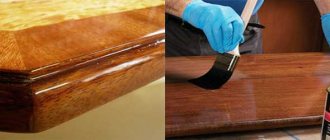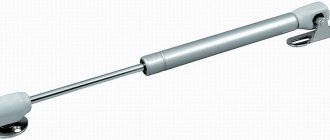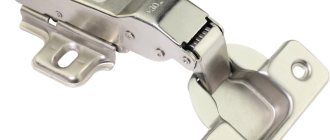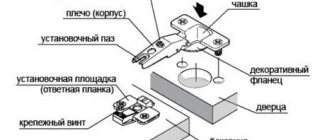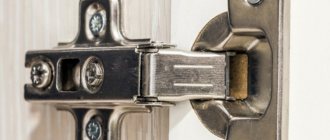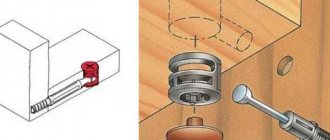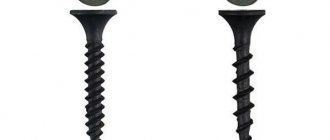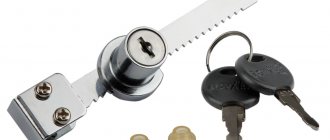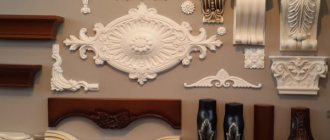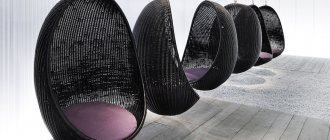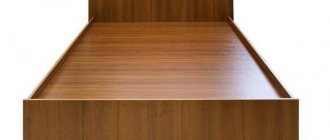The wear resistance of cabinets, tables, bedside tables largely depends on the quality of the fittings. This is a huge category of products, including hundreds of varieties of products, from guides to confirmations. Furniture hinges are irreplaceable elements; they allow you to conveniently open the doors at a certain angle. A few years ago the choice of this additional equipment was small, but today the situation has changed. Accessories such as hinges are classified according to design, materials of manufacture, and installation method, so to select the correct elements you need to know many nuances.
Basic characteristics
Furniture hinges are semi-mechanical devices for fastening the facade to the furniture body and making doors comfortable to use. Installation is carried out using self-tapping screws. The cup of the furniture hinge is fixed to the facade, and the mounting strip is fixed to the frame. There are several types of products depending on the opening angle:
- 45 degrees. Used for corner cabinets, trapezoid-shaped cabinets with one or two doors. This could be kitchen or wardrobe furniture.
- 90 degrees. Allows doors to be opened at right angles. There are several types of loops. Overlays do not require bending and are suitable for facades that completely cover the side walls. Semi-overlays have a medium twist, while internal ones have a large twist. The former are used in three-leaf wardrobes, the latter in office furniture.
- 165 degrees. Carousel loops are distinguished by the complex shape of the bowl elbow. Relevant for corner bedside tables.
- 180 degrees. Used for mounting false panels and connecting the facade to the sidewall. A popular option for kitchen sets.
- 270 degrees. Suitable for any folding door.
The selection of suitable hinges is based on the design features of the products. The purpose of the interior items must be taken into account. Other factors also matter: the intensity of use, the material from which the furniture is made.
Kinds
Today, the supporting fastening mechanism for modern furniture is manufactured in a huge range. A variety of furniture hinges, their versatility makes it possible to enjoy using kitchen sets, bedside tables, and easily close and open drawers, cabinets, and doors. Furniture hinges are divided into types according to their purpose, design features, and installation:
- invoices;
- semi-overhead;
- internal;
- corner;
- inverse;
- piano;
- card;
- mezzanine;
- secretory;
- gallery;
- card;
- pendulum;
- heel
Overhead and semi-invoice
Classic locking mechanisms are used for furniture, entrance, and interior doors. It has different shapes, sizes, and can withstand loads well. They ensure free opening and closing of the cabinet door at an angle of 90, support the doors at the required level, and prevent distortion. The hinges on the cabinet are attached with the main part to the side inner wall of the furniture.
Furniture holders differ from overhead holders in the bend of the base. The mechanism is fixed when it is necessary to mount two doors at once on one of the side doors, opening in different directions. Typically, such hinges are used for kitchen sets.
Semi-overhead
Semi-overhead and slip-on
Semi-overhead
Invoices
Invoices
Internal and corner
Furniture fittings have a general resemblance to a semi-overlay hinge, but with a deeper bend, mounted inside the body of the product, ideal for wooden cabinet doors and heavy cabinet doors. The mechanisms are attached at different angles to furniture doors, are widely used for corner cabinets, and have different configurations depending on the intersection of the installation planes. Corner hinges are produced for installation at an angle of 30°, 45°, 90°, 135°, 175°. They may have built-in or separate closers that allow the door to open smoothly.
Corner
Corner
Corner
Domestic
Domestic
Inverse and piano
Connection for furniture with a rotation angle of 180, widely used for the doors of built-in bedside tables and cabinets. The hinge securely connects the side post and the door, forming a straight line.
The connecting holder consists of two perforated plates, movably fastened to each other. Despite the fact that the furniture hinge is considered an outdated option, it is installed on swinging facades and in other products.
Piano hinges
Piano
Piano
Inverse
Inverse
Card
The design of the hinge for connecting furniture elements is similar to a piano mount. The fittings, consisting of two parallel plates connected by a hinge, are attached to the facade and frame through holes located along the edges. The mechanism comes in different sizes and is mainly used for retro furniture design and jewelry boxes.
Mezzanines and secretaries
The hinge is similar to an overhead fastener and is installed on the doors of kitchen wall cabinets. Fixed for vertical opening. Its main element is the spring.
Furniture hinges are designed for small desks with folding boards and front walls of cabinet furniture. A special feature of the mechanism is double adjustment, the presence of a secretory bracket, and convenient standard milling of holes with a diameter of 35 mm.
Secretaries
Secretaries
Secretaries
Mezzanine
Mezzanine
Gallery and card shops
The hinge, by its design, is considered the most popular fastener when it is necessary to connect a facade to a false panel at an angle of 90°. The fittings allow doors of any size or shape to close easily and silently.
A furniture holder designed for folding fronts is most often used in the production of kitchen tables. It is fixed at the ends of the connecting parts of the structure, which allows you to open the door 180 degrees.
Adit
Adit
Card
Card
Pendulum and heel
The main feature of the fastening is the ability to open the structure in different directions. The mechanism, being a type of door hardware, ensures that doors open 180 degrees. The loop has a highly specialized application; during installation, it requires correct and precise adherence to the instructions.
A simple type of hinge is mounted in the top and bottom corners of the box, secured using small cylindrical rods. The mechanism operates on the principle of hinged canopies. They are used in the manufacture of kitchen cabinets with light-weight doors for small spaces. The installation of hinges on glass facades is being considered.
Heel
Heel
Pendulum Pendulum
Pendulum
Manufacturing materials and design
Card loops, bar loops and other types of fasteners are made from different materials. The most common are steel and brass. When choosing, you need to take into account their properties and features:
- Steel. It has a shiny surface and an attractive appearance. Pros: high strength, affordable cost. Disadvantages: not suitable for the bathroom and other rooms with high humidity, rough ends, seams, have noticeable play, and after a couple of years they begin to creak.
- Brass. Hinges are manufactured to exact dimensions, so each product can be used as a template for insertion. Pros: the material does not rust, does not need lubrication, the surface is perfectly smooth, carefully processed, minimal play, high-quality galvanic coating, noble color. Disadvantages: the cost is several times higher than steel models, the products wear off during long-term use.
A mortise or invoice hinge made of brass will be of better quality in all respects compared to its steel counterparts, but it will also be 5–7 times more expensive. When choosing, you should be guided by your budget and feasibility of use.
Steel
Brass
Awnings differ not only in materials of manufacture, but also in design. Beautiful products will perform practical and decorative functions. Forged hinges fit organically into modern, loft, Provence, and Baroque interiors. Antique decoration is relevant for vintage, country, retro, high-tech styles, it is also in harmony with minimalism, gold plating is with the classic direction, art deco.
How to choose the right furniture hinges
Many manufacturers of furniture hinges produce low-quality fittings because they want to save on production. To purchase a quality product, it is worth looking at the thickness of the metal. If it is thin, it is better to refuse the purchase. It is worth paying attention to the price equivalent - it is better not to purchase cheap accessories. The number of items depends on the size of the façade and its weight. The hinges must be durable; this determines how long they can last.
This type of fittings, such as furniture hinges, currently produced and used in furniture assembly.
You can easily replace old fittings with new ones yourself, and the furniture will last for a long time.
To choose furniture hinges, you need to consider how you will install them. Many people pay attention to where they were made. After all, most of the accessories are produced in China, and there, as you know, they are manufactured under various brands, including well-known ones. It is important to pay attention to the product certificate, whether the head office controls production, since most popular companies open branches in the Middle Kingdom.
There are many types of furniture hinges.
Typically, furniture manufacturers carefully select fittings and give preference to brands that have characterized themselves positively.
All elements are connected to each other by a four-hinged mechanism.
Varieties according to installation method
The overhead or internal loop may differ in design. The bowl with the knee is fixed in different ways by the counter plate. Depending on these features, three types are distinguished:
- Side-on The structural elements are inserted into each other and fastened with a special screw with notches. The latter serve to reliably hold the connection in a weakened state. This variety is most widespread.
- Clip-on. The parts are snapped into place; no screws are used. The structure of the hinges allows you to remove and hang the doors without the use of tools. Relevant for quick installation.
- Key-hole. There is a hole on the surface of the cup shoulder that looks like a regular keyhole; the screw head passes through this slot, ensuring a secure fastening.
All of the listed types of 90 degree furniture hinges are four-hinged. The main differences are in the installation method and purpose. It is necessary to take into account the features of the facade and the mounting option.
Side-on
Clip-on
Key-hole
Hinge Attachment
Hinges are placed in the holes and, using a ruler or level, their position is adjusted relative to the height of the facade. Each canopy must tightly touch the surface of the facade. If the location of the awnings is not adjusted, the door may take an oblique position. When the hinges are aligned, you should make marks for the screws. This can be done with a pencil or with the screw itself. Next, use a screwdriver to screw the furniture hinges to the door.
Tips for choosing
A properly selected furniture hinge will ensure long-term use of the furniture. It is worth paying attention not only to the cost of products, but also to the main characteristics. Recommendations from experts will help you decide:
- The method of opening the door and the dimensions of the hinge are specified. Small facades require small canopies, and vice versa.
- Attention is paid to the manufacturer, the optimal ratio of cost and quality.
- During an external inspection of furniture corner hinges, the presence of dents, cracks and other defects is checked.
- Fittings must be certified in the Russian Federation; reliable sellers always have supporting documents.
- You should trust only specialized stores that sell original products. Qualified consultants will help you make the right choice and provide information on installation and maintenance of products.
Varieties of furniture fronts for cabinets, popular materials
All straight and corner furniture hinges, except cupless ones, are produced with or without closers. The action of this device can be compared to a shock absorber, which ensures smooth, silent closing of doors, without hitting the furniture body. Among the undoubted advantages of such an addition are an increase in the service life of structures, resistance to loads, and protection against leakage of oil and working fluid. The models are adjustable and serve for the tightest fit of surfaces.
For thick facades, hinges with a cup diameter of 45 mm are selected. A good option would be spring reverse models.
Specify the method of opening the door and the dimensions of the hinge
Pay attention to the manufacturer, the ratio of cost and quality
Check for dents, cracks and other defects
Ferrari hinge series
| Series | Cup diameter | Milling depth for cup | Series features |
| Slide on 95 | 35 mm | 11 mm | Loops in this series are the most common. To install on the pad, the hinge is “slided” onto the pad so that the mounting pad screw fits into the groove on the back of the hinge arm (see section “Installing Hinges”). In the MDM assortment, this series is represented as widely as possible - various types of hinges are available (inset, overhead, middle), as well as various installation and opening angles. |
| Slide on 96 | 35 mm | 11 mm | Externally they look like the hinges of the Slide on 95 series, differing from them in the type of spring - these hinges work to open the door throughout the opening cycle (unlike standard four-hinge hinges, which work in two directions - at the beginning of the opening cycle the spring tends to close the door, then , approximately from the middle of the opening cycle, the spring tends to open the door). Hinges of this series are used with the MAGIC system and are used in high-tech furniture (without handles on the doors). |
| Anyway Clip 90 | 35 mm | 11 mm | Hinges of this series are designed for quick installation, as well as for doors with 3 or more hinges. Their peculiarity is that there is no need to “push” the loop at a certain angle onto the platform; it snaps onto it from any position without the use of tools. Removing the hinge is also extremely simple - just pull the latch at the end of the hinge arm. Installation and dismantling of furniture can be done by one person. Large doors with three or more hinges cannot be installed alone. In the MDM assortment there is only one hinge of this series (straight invoice 90/110). |
| Mini 12 | 26 mm | 11.5 mm | Designed for lightweight doors. The hinges of this series differ from the Slide-on and Anyway Clip series by having a smaller cup diameter and, therefore, a lower maximum load. In the arm of the hinge there is a hole in the shape of a key hole, with which it is installed on the platform. These hinges are available for both chipboard doors and glass doors. |
| MiniMAX | 26 mm | 10 mm | Hinges in this series are also designed for small doors. They differ from the Mini 12 series in their smaller milling depth, and, accordingly, the ability to use chipboards with a thickness of 12 mm or more. The Slide-on type fastening allows independent adjustment (for more details, see the MiniMAX section). MiniMAX is designed for a greater number of opening/closing cycles than Mini 12. These hinges are available for both chipboard and glass doors. |
How to attach and adjust
Installation of 180 degree furniture hinges begins with disassembling the part. Overhead models with a diameter of 35 mm have become widespread. Before starting work, you need to prepare the following tools:
- screwdriver;
- ruler;
- drill;
- building level;
- cutter;
- screwdriver;
- screws;
- pencil.
The secretory loop and other products with cups allow for independent installation. If the procedure is being carried out for the first time, you should use step-by-step instructions:
- Marking. The location of the loop is marked. It is necessary to retreat from the edge of the facade by 10–12 cm. The distance between the canopies should be at least 50 cm.
- Creating holes. Using a drill or screwdriver, holes are made in accordance with the marks. For convenience, the door is placed on a hard surface.
- Installation. Loops are placed in the finished holes, and the position is adjusted relative to the facade height indicators. Places for screws are marked, canopies are screwed on.
- Door installation. First of all, markings are made, platforms are secured, and the facade is hung. After this, both parts of the loop are connected. The screws are tightened, adjusting the position relative to the cabinet.
- Checking and correcting fastening. After installing the facade, it is necessary to adjust the hinges in three planes: vertical, horizontal, and also relative to the installation depth.
Corner hinges are installed using the same principle. Not all craftsmen know how to adjust canopies; however, you will need to press and loosen the facade in relation to the frame, tighten the oval holes, check the movement from left to right and back. This will help eliminate cracks and prevent facades from sagging.
A wise choice, high-quality materials, correct installation of 45-degree furniture hinges, as well as 90 and 180° models, are the key to comfortable use and durability of interior items. Thanks to the wide range of products, you can find suitable options for a wide variety of cabinets, bedside tables, and tables. Installation of canopies does not require special skills; it occurs quickly and without unnecessary effort.
Prepare tools
Marking
Creating holes
Installation
Door installation
Checking and correcting fastening
Hole preparation
To understand how to properly install and hang hinges, it is important to follow all the required steps. The next installation stage is how to embed furniture hinges? Using a drill or screwdriver, you need to drill holes. In this case you need to use a cutter. The facade is laid on a hard surface. Drilling is carried out in the place of the marking.
Installation of a furniture hinge is carried out taking into account the following conditions:
- The hole depth is 12-13 mm. The cut-in should not be deeper to avoid cracks appearing on the front side of the door;
- the use of a sharpened cutter helps to avoid chipping or damage to the surface of the facade;
- the drill or screwdriver should be vertical, corresponding to the drilling axis, to avoid damage to the surface;
- Drilling should not be done in a hurry, otherwise the resulting hole will be sloppy.
After drilling for one hole, the following slots are drilled. When all the holes are made, the stage of laying the loop cups in them follows.
Adjustment
Adjustment (or adjustment) is the final stage of installation of furniture hinges. It must be performed in several planes at once - vertically, horizontally, and in relation to depth:
- Adjusting the depth will help press the door closer to the body, or ease the pressure. You need to tighten the oval hole.
- On the vertical side - it will help to move the facade. This is done by twisting oval-shaped holes.
- On the horizontal side - ensures free movement of the door back and forth and back. The purpose of this adjustment is to avoid gaps between the cabinet and the door. The method is great for rooms with uneven floors or walls.
Now you know how to secure furniture hinges. As you can see, this is not so difficult to do. You don't need to have any special skills or abilities. Doing this kind of work with your own hands will be another reason for a little pride.
Types and characteristics of furniture hinges, fastening rules
The wear resistance of cabinets, tables, bedside tables largely depends on the quality of the fittings. This is a huge category of products, including hundreds of varieties of products, from guides to confirmations. Furniture hinges are irreplaceable elements; they allow you to conveniently open the doors at a certain angle. A few years ago the choice of this additional equipment was small, but today the situation has changed. Accessories such as hinges are classified according to design, materials of manufacture, and installation method, so to select the correct elements you need to know many nuances.
The nuances of installing soft-closing furniture hinges
Often in articles you can find “life hacks” for saving money when purchasing and installing accessories, which are very controversial. And even harmful.
Myth 1. You can’t install door closers on all kitchen doors, but only on those that you use most often . Dubious recommendation. From my own experience I can say that you quickly get used to good things. And if you are used to a certain opening of the facade, knowing that it will close smoothly and silently, you will close all the others in the same way, with the go-ahead. Wincing every time from the knock. It's annoying. As practice shows, if you install furniture hinges with closers only in the kitchen, then you will want to install them on all the cabinets in the house. Moreover, the costs are not that high.
Myth 2. You can install one hinge with a closer on each door, combining it with conventional ones . You shouldn't do this either. The hinges on each facade must be of the same type, from the same manufacturer and preferably from the same series. The shape of the shoulder and, in general, the principle of operation of furniture hinges with and without a closer/shock absorber are different, and the rigidity is also different. If there are no problems initially with adjusting the gaps, they will definitely make themselves known later, warping and deforming the door when opening.
The only savings that are justified are the installation of conventional hinges on facades with upward opening and fixation with a lifting mechanism. The gas lift will still not allow the loop with the closer to work as it should. Therefore, standard furniture hinges can be installed on facades with such an opening.
Otherwise, the installation of furniture hinges is completely ordinary, just like on the others; you can read about it here.
